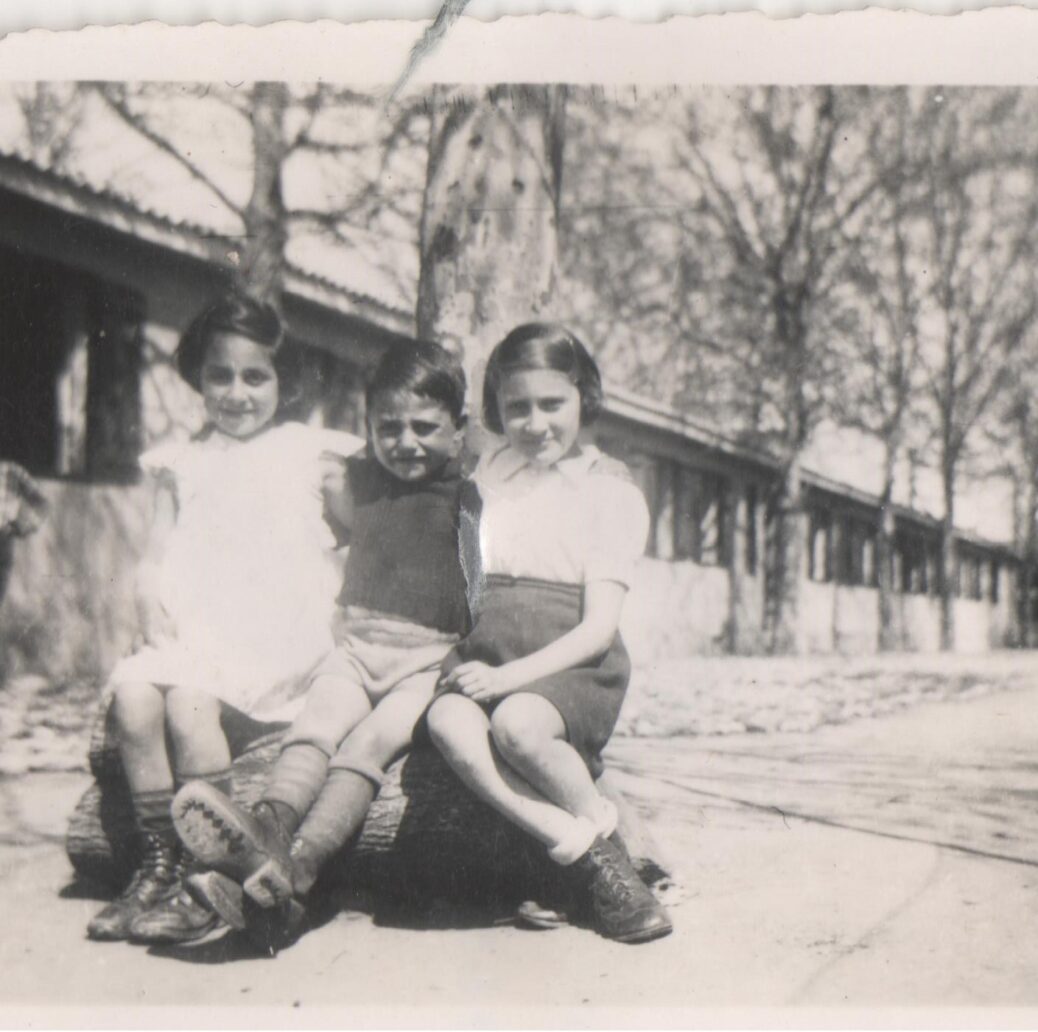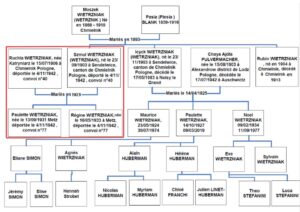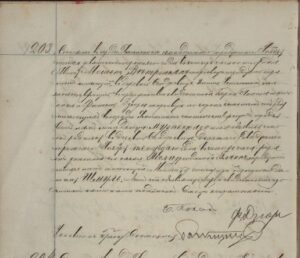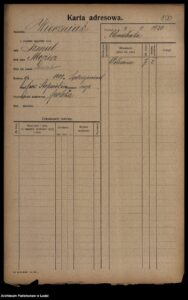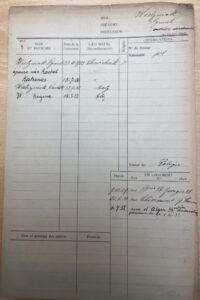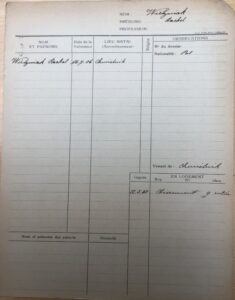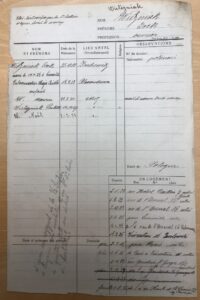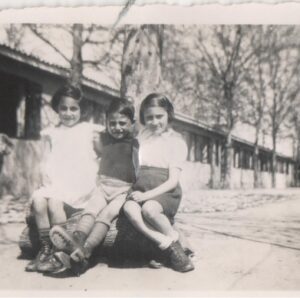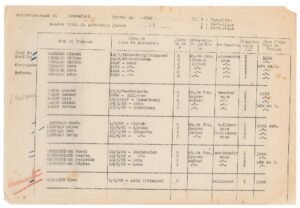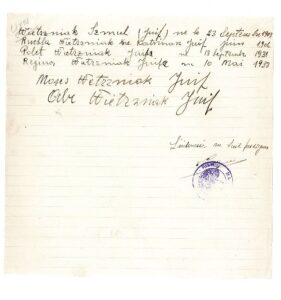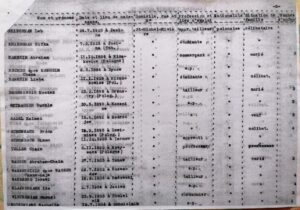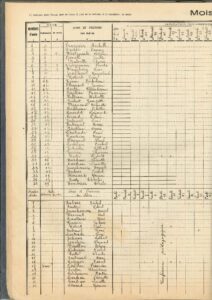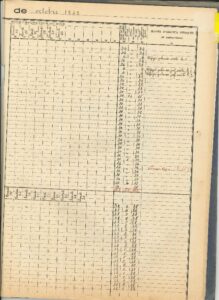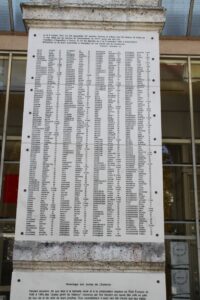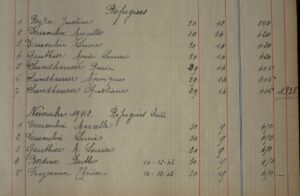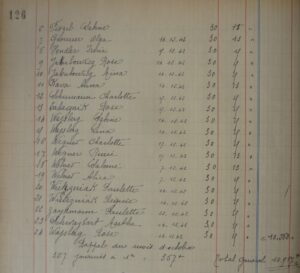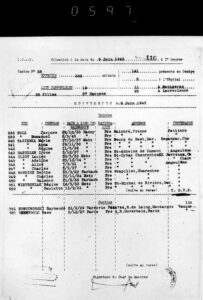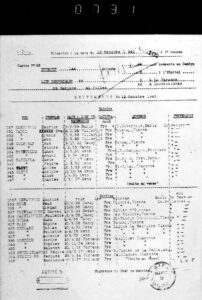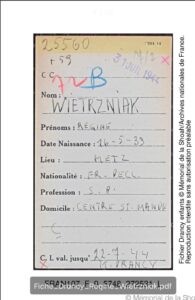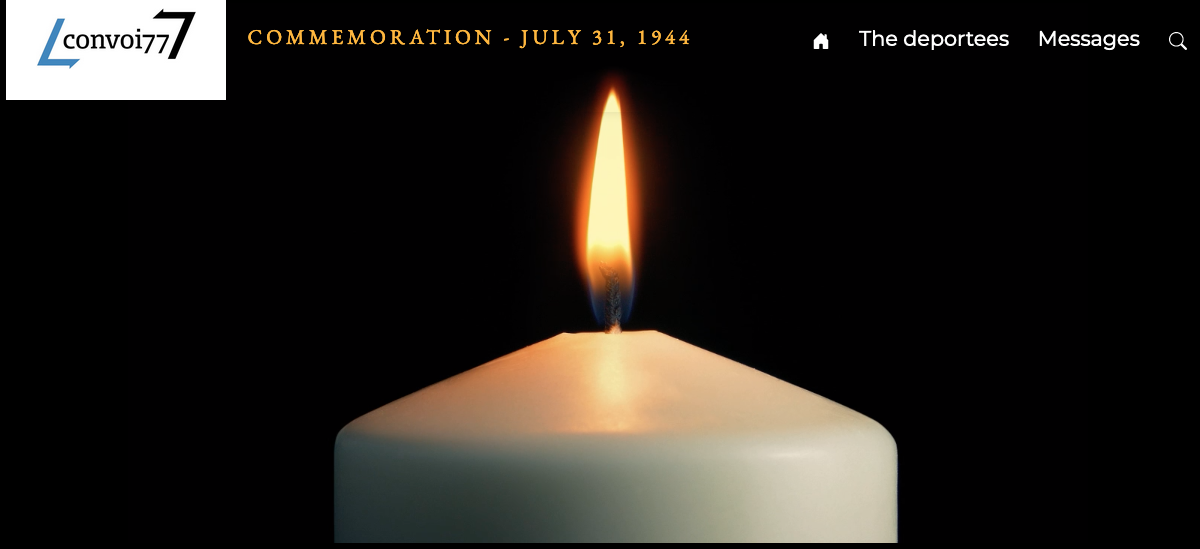Régine WIETRZNIAK
Photo thought to be of Régine and Paulette Wietrzniak with their cousin, Noël Wietrzniak, taken in around 1938. (Eve Wietrzniak’s collection)
I. Introduction to the Wietrzniak family
1. Genealogy
The Wietrzniak family tree below gives a clearer picture of the relationships between family members and the history of the family. All of them are descended from Moszek and Pesla Blank, who were married in Chmielnik, Poland, in 1893. They had three children: Rubin, Icyk, and Szmul Wietrzniak, the latter being the father of the two girls we are going to tell you about. Paulette and Régine Wietrzniak were born on September 13, 1931, and May 16, 1933, respectively, in Metz, in the Meurthe-et-Moselle department of France. Sadly, simply they were Jewish, the two girls were deported on Convoy 77 in July 1944, and met the same the tragic fate as thousands of other Jewish children during the Second World War.
The Wietrzniak family tree, showing five generations of the family
2. Régine and Paulette’s parents
Before we discuss what happened to Régine and her sister Paulette, let us start with their parents and their family background, in order to better understand what happened in the years leading up World War II. Their father, Szmul Wietrzniak, was born on September 23, 1903, in Chmielnik, which was then part of Russian Poland. At the time, Poland was home to one of the largest Jewish communities in Europe. There were many Jewish families in Chmielnik, which had a large synagogue where members of the Jewish community would gather together. In 1920, Szmul moved to the city of Lodz, but there is no record of how long he stayed there. In April 1929, he married Ruchla Katriniarz, who was born in Chmielnik on July 15, 1906. He was a shoemaker, which was a fairly common occupation at the time.
Szmul Wietrzniak’s birth certificate (from the Polish State archives in Kielce. Sent by Ms. Agnieszka Jardel, translated by Ms. Olga Perrot)
Szmul’s residence record from Lodz, dated 1920
(Found Eve Wietrzniak, Szmul’s granddaughter, on a Jewish genealogy website)
3. The family’s move to Metz
According to the residence records in the Metz municipal archives, Szmul and Ruchla emigrated to France shortly after they got married. They were one of the many Jewish families from Eastern Europe who fled discrimination in their home countries and settled in Metz, where there was already a well-established Jewish community. Initially, in December 1929, Szmul moved to Rue de la Boucherie Saint-Georges, where his brother Icyk, who was only two years older than him, lived with his wife and their first two children. Shortly afterwards, in late January, he moved to 9 rue Chèvremont, and Ruchla came to join him in March. The couple lived there for two years and then in July 1932 moved to 2 rue d’Alger. These three places are all very close to each other. Szmul worked as a shoemaker during this time.
Szmul Wietrzniak’s residence record (Metz municipal archives)
Ruchla Wietrzniak’s residence record (Metz municipal archives)
Icyk Wietrzniak’s residence record (Metz municipal archives)
Their two daughters were born nearby, in the Sainte Croix maternity hospital: Paulette on September 13, 1931, and Régine on May 16, 1933. We know very little about Régine and Paulette’s lives in Metz , other than that they lived near their three first cousins. Icyk had a third child, Noël, in 1934, who was therefore almost the same age the two girls. Eve has a photograph of her father, Noël, with two young girls who he appears to be very close to. They could well be Paulette and Régine. If so, this is the only surviving photograph of the two sisters and confirms how close the cousins were.
Photo of Noël Wietrzniak with two girls who could well be Paulette and Régine. It was probably taken at Marvejols, in the Lozère department of France, in around 1938. (Eve Wietrzniak’s collection).
II. At the start of the Second World War, the family fled to Yves
When World War II broke out in September 1939, it was impossible not to be aware that the Nazis hated Jews. Many Jewish families in the Lorraine region of France were afraid that the Germans would invade the area, so decided to flee. Most were evacuated by train to the Charente-Inférieure department of France. However, the Nazis caught up with them in June 1940, when, following the signature of the armistice on June 22, the entire Atlantic coast became part of the German-occupied zone. Soon afterwards, the Vichy regime began collaborating with the Germans, and in October 1939, it passed the first of a series of anti-Semitic laws.
We do not know exactly when the Wietrzniak family left Metz. The next trace we found of them was in Yves, on the Atlantic coast, when they had to take part in a census of Jews in October 1940. From then on, like all other Jewish families, they were strictly monitored. Szmul declared himself, his wife and his children, but there are also two other people listed, Moses and Abr(aham) Wietrzniak, but we do not know who they were.
Extract from the census of Jews living in Yves in October 1940
(Charente Maritime departmental archives)
Census declaration for the Wietrzniak family, made in October 1940
(Charente Maritime departmental archives)
III. In November 1940, the Wietrzniak family was moved to Saint-Michel-de-Rivière
The census enabled the Vichy regime and the German authorities to monitor the Jewish population closely. The following month, the Wietrzniak family was transferred to Saint-Michel-de-Rivière, a little village in the occupied part of the Dordogne department of France. We have no details about the family’s life in the village, but based on other families’ accounts, we gather that they led a peaceful existence. However, they had to register with the authorities again in July 1942, just a few days after the Vel d’Hiv roundup in Paris, during which the French police arrested more than 13,000 Jews, many of them children, and sent them to the camps. This second census proved to be a turning point for the Wietrzniak family.
Census of foreigners living in St-Michel-de-Rivière on July 20, 1942
(Dordogne departmental archives)
In the 1942-1942 register from the elementary school in Saint-Michel-de-Rivière school for the 1942-1943 school year, Régine is listed as having been enrolled at the start of the school year in October, and the words “Polish refugee – arrested on the 9th” are written beside her name.
Page from the Saint-Michel-de-Rivière elementary school register
(Saint-Michel-de-Rivière municipal archives)
IV. The family was torn apart after being rounded up and taken to the Philharmonic Hall in Angouleme
During the night of October 8-9, 1942, there was a major roundup of foreign Jews throughout the Charente department and in the occupied part of the Dordogne. 442 people were arrested, simply because they were Jewish, and held in the Philharmonic Hall in Angouleme. Régine and Paulette, who were French citizens, were released after a few days. However, their parents, who still held Polish nationality, were transferred to Drancy on October 15, 1942. Located in the north of Paris, Drancy was an internment camp where Jews were held pending deportation to Nazi concentration camps. At that time, the French authorities were responsible for running it. Drancy was a dreadful place, where living conditions were abysmal: the camp was overcrowded, people were malnourished and subjected to brutal treatment, and sanitary facilities were almost non-existent. Shortly after they were interned there, Szmul and Ruchla were deported to Auschwitz-Birkenau on Convoy 40 on November 3, 1942. For the vast majority of the 1,000 Jewish people who left that day, it was a one-way journey.
Plaque commemorating the victims of the roundup that took place on October 8, 1942, outside what is now the Gabriel Fauré music academy in Angouleme
Paulette and Régine did not know that they were soon to be orphans. Fortunately however, at least they were able to stay together. Along with 19 other girls, they were taken in by the nuns at the Bon Pasteur convent in Angouleme, where they stayed for a month or so. The convent was paid a daily allowance for each girl’s food and board. However, at the request of Rabbi Bloch (a rabbi from Metz who had fled to Poitiers), the children were then placed with French Jewish families. Régine and Paulette left the Bon Pasteur convent on December 15, but we do not know if they both stayed with the same family.
Extract from the Bon Pasteur convent accounts, from November 1942
(Bon Pasteur convent archives)
V. The two girls in the UGIF centers
1. Régine and Paulette were moved to the Lamarck center
UGIF centers were children’s homes run by the UGIF (Union Générale des Israélites de France, or General Union of French Jews). The Vichy regime founded the UGIF in November 1941, during the German occupation and at the behest of the Nazis. Its real purpose was to keep track of the Jews whereabouts so they would be easier to find and arrest at a later date. Officially, however, the UGIF was responsible for representing Jews in France and providing social assistance, in particular to orphans and families affected by the Vichy regime’s anti-Semitic laws.
UGIF centers were opened in various cities in France, mainly in Paris and in the south of the country. They took in Jewish children whose parents had been arrested or deported and also, in some cases, adults who were in serious difficulty. The homes were intended to keep the children safe, but unfortunately this also made it easier for the Nazis to keep track of the children so they could round them up and deport them.
Regine and Paulette were thus sent to the UGIF home on Rue Lamarck in Paris, also referred to as Center No. 28. They arrived there on June 9, 1943, along with a group of other children from Angouleme who had also been separated from their parents. We do not know the names of families they had been staying with since left the Bon Pasteur convent.
According the arrivals and departures log, the two girls left the Larmarck center on September 3, 1943. They were sent to another UGIF home in Louveciennes, outside the city, for a summer vacation, and stayed there until October 12.
Page from the list of children staying in, arriving at and leaving UGIF center N°. 28 (the Larmarck center) on June 9, 1943
Page from the list of children staying in, arriving at and leaving UGIF center N°. 28 (Larmarck center) on September 3, 1943
Page from the list of children staying in, arriving at and leaving UGIF center N°. 28 (Larmarck center) on October 12, 1943
2. The girls’ stay in the UGIF home in Saint-Mandé
Régine and Paulette were then transferred to another UGIF home, this time in Saint-Mandé, on the outskirts of Paris. We do not know when exactly the girls arrived there, as there are no records available. However, according to a commemorative plaque at the nearby Paul Bert elementary school, both girls were enrolled there. They were arrested, along with all the other children from Saint-Mandé and the various other UGIF centers in and around Paris, on July 22 1944.
The commemorative plaque at the Paul Bert elementary school in Saint-Mandé (May 25, 2023)
VI. Régine and Paulette’s time in Drancy, where they were interned until they were deported
After they were arrested, Régine and Paulette were interned in Drancy camp, north of Paris. We can only imagine what they had to endure there, based on survivors’ testimonies. The camp was overcrowded and the sanitation appalling. The internees suffered from malnutrition, brutal treatment and constant humiliation. They were all assigned a number when the first arrived : Pauline’s was 25,559 and Régine’s 25,560. They stayed in room 2 on staircase 7.
Régine Wietrzniak’s internment record from Drancy camp
(French National archives, ref., F9 5748)
From the moment the two girls arrived in Drancy, their fate was sealed. Nine days later, on July 31, 1944, the girls, the manager of the Sainte-Mandé center, Ms. Cahen, and all the children from the other UGIF centers were deported on Convoy 77 to the Auschwitz extermination camp. In all likelihood, when the girls arrived in Auschwitz on August 3, they were immediately sent to the killing center, which is to say to the gas chambers, because they were so young and unable to work. Many years later, in 2011, they were officially declared to have died on August 5, 1944.
Acknowledgements: We would like to thank everyone who helped us with this project, in particular the members of the Wietrzniak family, who we were privileged to have the opportunity to work with. We would also like to thank Mr. Gérald Sim, a history and geography teacher from La Rochelle, in the Charente Maritime department of France, who provided us with many useful resources that contributed greatly to our research.


 Français
Français Polski
Polski